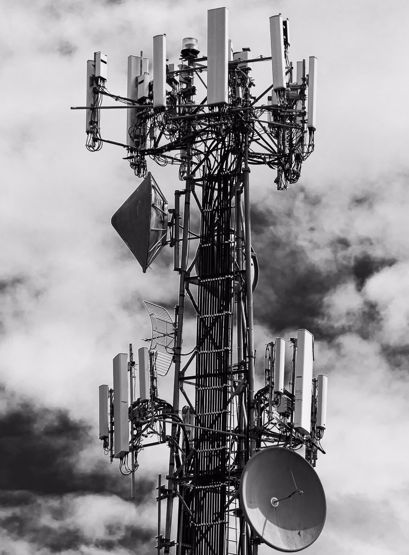Noemi Ristau, a 27 year-old German paralympic skier, is blind. The process started 15 years ago but this hasn’t stopped her from becoming one of the most successful sportsmen. She always had to ski with the assistance of her guide Paula who would notify her about the turns with a microphone. You can imagine how dangerous this was. It takes the voice from a microphone a couple of seconds to reach the respondent’s ear. In an extreme situation as such, that’s just too much.
In June 2019 Noemi Ristau skied down a mountain alone for the first time after becoming blind.
Her guide was helping her out from a room this time. Through the cameras tied to Noemi’s head, Paula could see the road in front of her and give directions through a microphone. But, this time, the answer went through in 10 milliseconds. This is the same amount of time needed for the brain to generate impulses. Such speed was enabled through 5G internet.
“From the moment I stood up, I was really excited to ski down alone. I hadn’t known that feeling for such a long time,” says Noemi.
Why is this story so important?
Physically impaired people have always existed in our society and always will. Most of them cannot live independently and they stumble upon many issues throughout their everyday lives. According to the international blind federation, around 70% of the blind don’t have a job. If we account for the fact that independence goes hand in hand with work, this statistic shouldn’t surprise us. But, all of this will soon change.
Taking care of the people with disabilities is one of the important missions of our society and 5G internet offers unique opportunities to do so.
Before we go on to talk about what advancements the 5G internet bring, let’s explain in short how it will manage to do so anyway.
What are the advantages of 5G internet?
-
High bandwidth - This means that 5G will be able to connect a lot more devices to the internet from one spot, at a given time. For the development of the Internet of Things (IoT), self-driving cars, and smart cities, this is very much needed.
This for a better understanding of 5G internet. Now let’s dive into the specific use-cases for those with disabilities.
Transportation
This is probably the biggest problem of the impaired. You will agree that the canes for the blind and traffic lights with voice signals just aren’t enough. How will the internet solve this problem?
Imagine a blind person equipped with smart glasses with a video camera and headsets. Artificial Intelligence implemented in the glasses (that is better fine tuned thanks to the 5G) will interpret the surroundings in real time and will notify the person through a microphone about it. Such devices will be able to support navigation through stores and to identify the products, reading aloud their descriptions.
It’s interesting to know that an analogue of such services already exists on the market - a mobile app called Aira. But, the biggest challenge for them is the fact that instead of virtual assistants they have real people assisting the blind. This substantially decreases the amount of people they are able to help at any given moment.
Another significant project is Loro founded by students from Harvard and MIT. The team is working on the development of a device that will support wheelchairs. Their system combines cameras with vision by 360 degrees, a voice assistant, a screen that reacts on eye movement, a laser for pointing at objects… In a word, Loro aims to fully assist people in wheelchairs. But, in contrast to Aira, Loro’s founders say that 5G internet is crucial for bringing their product to mass production.
When we add autonomous vehicles to such systems, we’re reaching a new level of transportation for the impaired.
Soon the writers and directors in the science fiction genre will need to widen their imagination.
Communication
You’ve probably often been disturbed by weak connections while talking through a video call. The signal is often lost which results in bad voice and frame transmission. For us this is just a small inconvenience, but for those who have a hard time communicating even in real life, this is a big problem.
For people with hearing disabilities, sign language is the only way to communicate. Even a small issue with internet connection is a big problem for them. With the help of 5G internet though, video calls will become problem free.
One of the most significant achievements in this regard is the development of Real Time Text (RTT). RTT is a way of texting in which the recipient sees instantly every letter that the sender types. For standard communications this is a little too creepy, but when we talk about calling the ambulance or any other emergency, the benefits of RTT are undoubtful. On top of that, those with hearing and talking disabilities, RTT provides amazing opportunities.
Experiences
When 5G internet-enabled AR/VR technologies come into play, everything starts to look even more like science fiction.
Those who can’t leave their homes for various reasons can still have real-world experiences from their home like traveling to different countries and so on.
Even more amazing is the fact that an AR connected to the 5G internet will seamlessly assist people with communication and learning disabilities in real time. The technology will help them identify expressions of the talker as well as help them better understand and remember new information.




5G vs. environment of limited abilities
31 August 2020Noemi Ristau, a 27 year-old German paralympic skier, is blind. The process started 15 years ago but this hasn’t stopped her from becoming one of the most successful sportsmen. She always had to ski with the assistance of her guide Paula who would notify her about the turns with a microphone. You can imagine how dangerous this was. It takes the voice from a microphone a couple of seconds to reach the respondent’s ear. In an extreme situation as such, that’s just too much.
In June 2019 Noemi Ristau skied down a mountain alone for the first time after becoming blind.
Her guide was helping her out from a room this time. Through the cameras tied to Noemi’s head, Paula could see the road in front of her and give directions through a microphone. But, this time, the answer went through in 10 milliseconds. This is the same amount of time needed for the brain to generate impulses. Such speed was enabled through 5G internet.
“From the moment I stood up, I was really excited to ski down alone. I hadn’t known that feeling for such a long time,” says Noemi.
Why is this story so important?
Physically impaired people have always existed in our society and always will. Most of them cannot live independently and they stumble upon many issues throughout their everyday lives. According to the international blind federation, around 70% of the blind don’t have a job. If we account for the fact that independence goes hand in hand with work, this statistic shouldn’t surprise us. But, all of this will soon change.
Taking care of the people with disabilities is one of the important missions of our society and 5G internet offers unique opportunities to do so.
Before we go on to talk about what advancements the 5G internet bring, let’s explain in short how it will manage to do so anyway.
What are the advantages of 5G internet?
Speed - The transmission speed in 5G internet will reach 15 to 20 Gbps. The standard speed of 4G is 5-12 Mbps.
Low latency (Time needed to fulfill the given task) - In comparison, 5G will have 10 times less latency than 4G does. This means that it will enable almost real-world operation. Noemi’s example is a demonstration of this quality.
High bandwidth - This means that 5G will be able to connect a lot more devices to the internet from one spot, at a given time. For the development of the Internet of Things (IoT), self-driving cars, and smart cities, this is very much needed.
This for a better understanding of 5G internet. Now let’s dive into the specific use-cases for those with disabilities.
Transportation
This is probably the biggest problem of the impaired. You will agree that the canes for the blind and traffic lights with voice signals just aren’t enough. How will the internet solve this problem?
Imagine a blind person equipped with smart glasses with a video camera and headsets. Artificial Intelligence implemented in the glasses (that is better fine tuned thanks to the 5G) will interpret the surroundings in real time and will notify the person through a microphone about it. Such devices will be able to support navigation through stores and to identify the products, reading aloud their descriptions.
It’s interesting to know that an analogue of such services already exists on the market - a mobile app called Aira. But, the biggest challenge for them is the fact that instead of virtual assistants they have real people assisting the blind. This substantially decreases the amount of people they are able to help at any given moment.
Another significant project is Loro founded by students from Harvard and MIT. The team is working on the development of a device that will support wheelchairs. Their system combines cameras with vision by 360 degrees, a voice assistant, a screen that reacts on eye movement, a laser for pointing at objects… In a word, Loro aims to fully assist people in wheelchairs. But, in contrast to Aira, Loro’s founders say that 5G internet is crucial for bringing their product to mass production.
When we add autonomous vehicles to such systems, we’re reaching a new level of transportation for the impaired.
Soon the writers and directors in the science fiction genre will need to widen their imagination.
Communication
You’ve probably often been disturbed by weak connections while talking through a video call. The signal is often lost which results in bad voice and frame transmission. For us this is just a small inconvenience, but for those who have a hard time communicating even in real life, this is a big problem.
For people with hearing disabilities, sign language is the only way to communicate. Even a small issue with internet connection is a big problem for them. With the help of 5G internet though, video calls will become problem free.
One of the most significant achievements in this regard is the development of Real Time Text (RTT). RTT is a way of texting in which the recipient sees instantly every letter that the sender types. For standard communications this is a little too creepy, but when we talk about calling the ambulance or any other emergency, the benefits of RTT are undoubtful. On top of that, those with hearing and talking disabilities, RTT provides amazing opportunities.
Experiences
When 5G internet-enabled AR/VR technologies come into play, everything starts to look even more like science fiction.
Those who can’t leave their homes for various reasons can still have real-world experiences from their home like traveling to different countries and so on.
Even more amazing is the fact that an AR connected to the 5G internet will seamlessly assist people with communication and learning disabilities in real time. The technology will help them identify expressions of the talker as well as help them better understand and remember new information.
But, even though the implementation of such systems is unavoidable, we’ll still have to wait until theory becomes reality. There will be many obstacles along the way but the world's leading companies are already hard at work to build our future. As USA’s biggest telecommunications company AT&T states:
“Our vision for our 5G network is crystal clear, and we're already bringing it to life.”